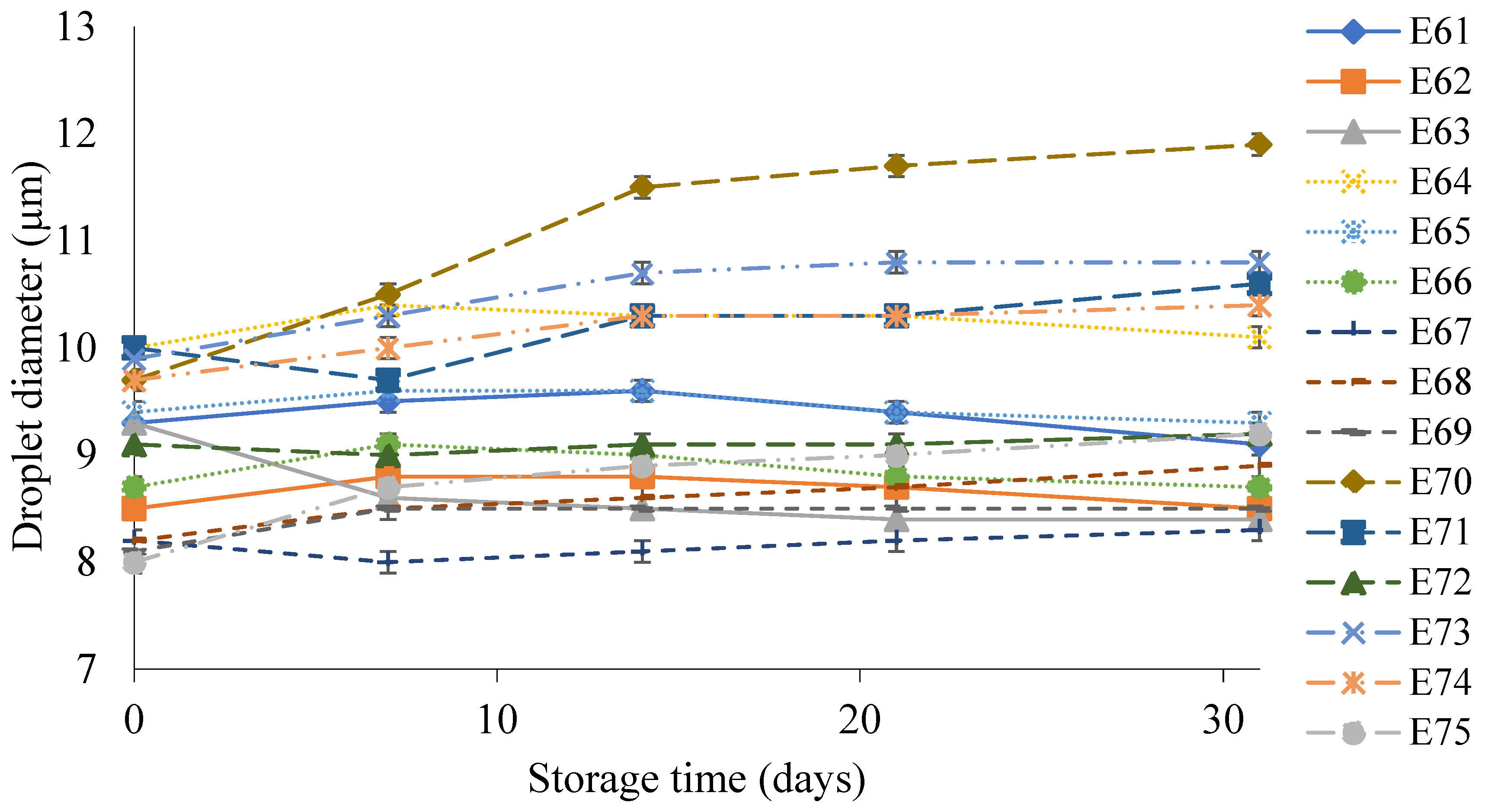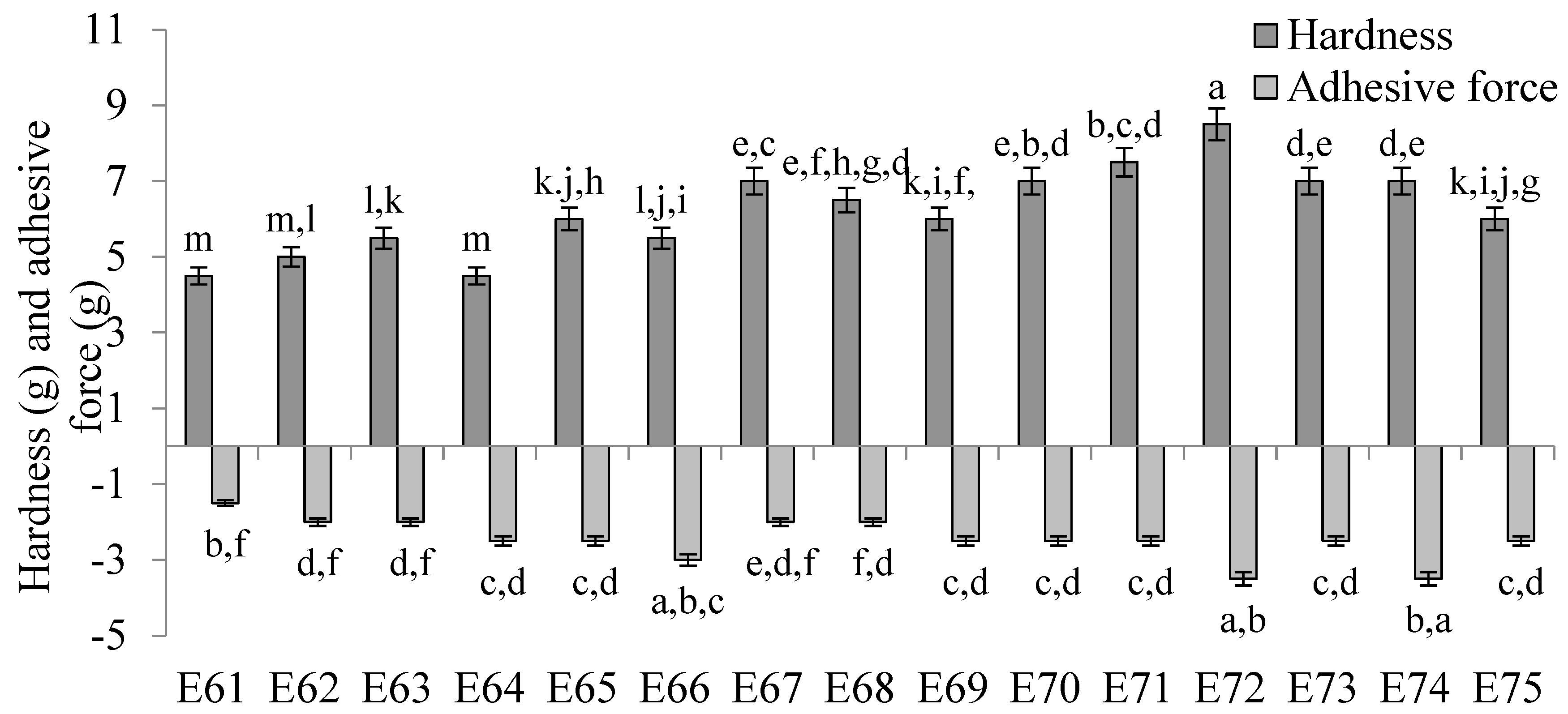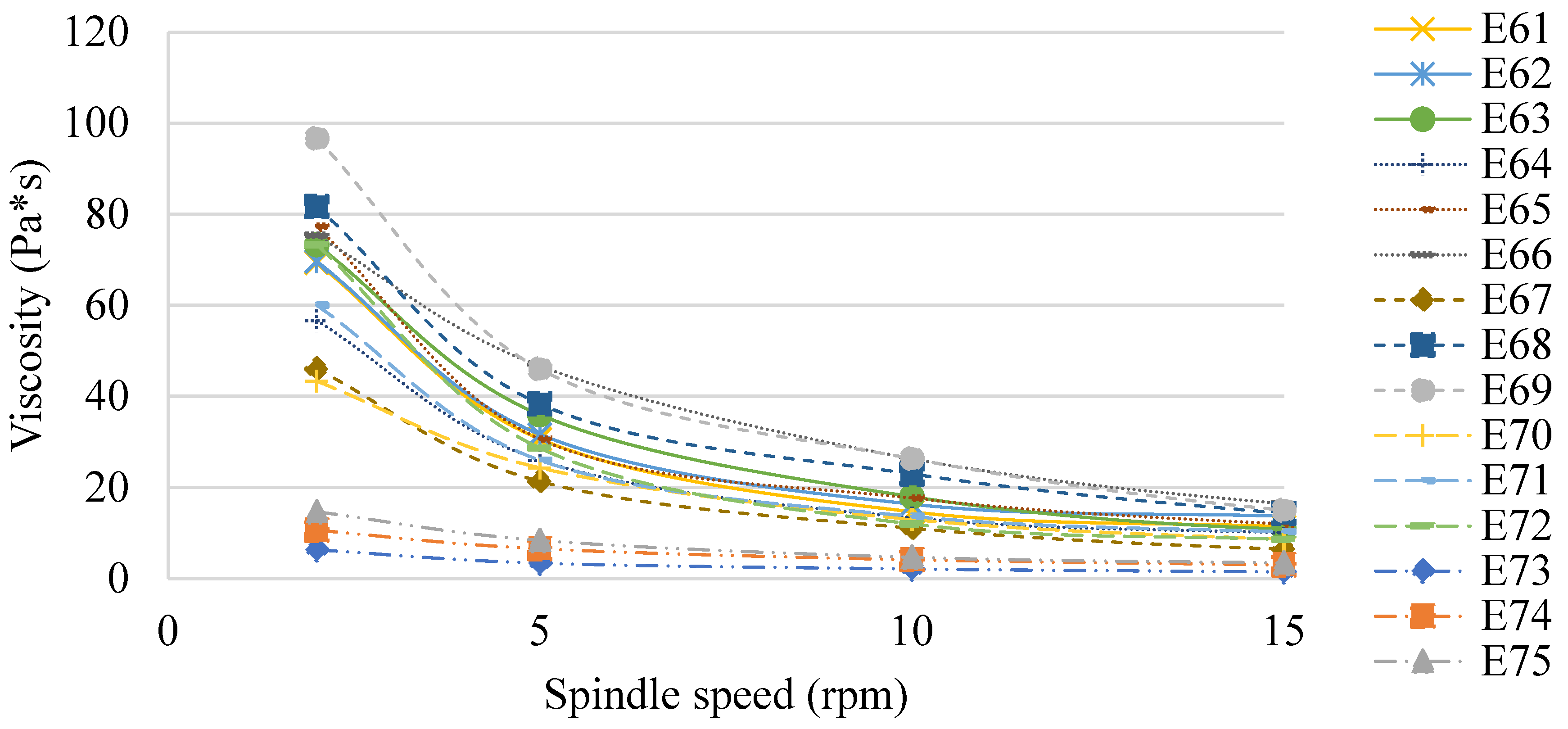Xanthan Gum and Microcrystalline Cellulose as Stabilizers in Emulsions Containing Catalytically Modified Animal and Vegetable Fat
Abstract
:1. Introduction
2. Results and Discussion
3. Material and Methods
3.1. Research Material
3.2. Research Methodology
3.2.1. Procedure for the Enzymatic Reaction of the Fatty Mixtures of Mutton Tallow and Hemp Seed Oil
3.2.2. Preparation of Emulsion
- The aqueous phase of the emulsion was a mixture of water and XGCM. This phase was prepared by adding the viscosity modifier in small portions to a beaker of water placed on an activated magnetic stirrer. The mixing process lasted 30 min, and then the total was homogenized for 1 min and left for 24 h.
- The next step was to heat both phases (water and fat) to 50–55 °C.
- Both phases were mixed and homogenized using an Ultra-Turrax T18 rotor-stator homogenizer equipped with an S18G–19G dispersing tool (IKA, Guangzhou, China).
- A preservative was added to the finished emulsions.
3.3. Methods to Evaluate the Quality of Emulsion Systems
3.3.1. Determination of Emulsion Stability Using the Turbiscan Test
3.3.2. Microstructure Evaluation of Emulsion Systems
3.3.3. Emulsion Texture Determination
3.3.4. Dynamic Viscosity Determination
3.3.5. Statistical Analysis
4. Conclusions
Author Contributions
Funding
Data Availability Statement
Conflicts of Interest
References
- Dijkstra, A.J. Interesterification, chemical or enzymatic catalysis. Lipid Technol. 2015, 27, 134–136. [Google Scholar]
- Sheldon, R.A.; John, M.W. Role of biocatalysis in sustainable chemistry. Chem. Rev. 2018, 118, 801–838. [Google Scholar] [CrossRef]
- Bilal, M.; Zhao, Y.; Noreen, S.; Shah SZ, H.; Bharagava, R.N.; Iqbal, H.M. Modifying bio-catalytic properties of enzymes for efficient biocatalysis: A review from immobilization strategies viewpoint. Biocatal. Biotransfor. 2019, 37, 159–182. [Google Scholar] [CrossRef]
- Rozendaal, A.; Macrae, A.R. Interesterification of oils and fats. In Lipid Technologies and Applications; Routledge: New York, NY, USA, 2018; pp. 223–263. [Google Scholar]
- Singh, P.K.; Chopra, R.; Garg, M.; Dhiman, A.; Dhyani, A. Enzymatic interesterification of vegetable oil: A review on physicochemical and functional properties, and its health effects. J. Oleo Sci. 2022, 71, 1697–1709. [Google Scholar] [CrossRef] [PubMed]
- Zbikowska, A.; Onacik-Gür, S.; Kowalska, M.; Zbikowska, K.; Feszterová, M. Trends in fat modifications enabling alternative partially hydrogenated fat products proposed for advanced application. Gels 2023, 9, 453. [Google Scholar] [CrossRef] [PubMed]
- Singh, R.D.; Kapila, S.; Ganesan, N.G.; Rangarajan, V. A review on green nanoemulsions for cosmetic applications with special emphasis on microbial surfactants as impending emulsifying agents. J. Surfactants Deterg. 2022, 25, 303–319. [Google Scholar] [CrossRef]
- Venkataramani, D.; Tsulaia, A.; Amin, S. Fundamentals and applications of particle stabilized emulsions in cosmetic formulations. Adv. Colloid Interface Sci. 2020, 283, 102234. [Google Scholar] [CrossRef]
- McClements, D.J.; Jafari, S.M. Improving emulsion formation, stability and performance using mixed emulsifiers: A review. Adv. Colloid Interface Sci. 2018, 251, 55–79. [Google Scholar] [CrossRef]
- Angardi, V.; Ettehadi, A.; Yücel, Ö. Critical review of emulsion stability and characterization techniques in oil processing. J. Energy Resour. Technol. 2022, 144, 040801. [Google Scholar] [CrossRef]
- Nsengiyumva, E.M.; Alexandridis, P. Xanthan gum in aqueous solutions: Fundamentals and applications. Int. J. Biol. Macromol. 2022, 216, 583–604. [Google Scholar] [CrossRef] [PubMed]
- Petri, D.F. Xanthan gum: A versatile biopolymer for biomedical and technological applications. J. Appl. Polym. Sci. 2015, 132, 42035. [Google Scholar] [CrossRef]
- Furtado, I.F.; Sydney, E.B.; Rodrigues, S.A.; Sydney, A.C. Xanthan gum: Applications, challenges, and advantages of this asset of biotechnological origin. Biotechnol. Res. Innov. 2022, 6, e202204. [Google Scholar] [CrossRef]
- El-Sakhawy, M.; Hassan, M.L. Physical and mechanical properties of microcrystalline cellulose prepared from agricultural residues. Carbohydr. Polym. 2007, 67, 1–10. [Google Scholar] [CrossRef]
- Krawczyk, G.; Venables, A.; Tuason, D. Microcrystalline cellulose. In Handbook of Hydrocolloids, 2nd ed.; Phillips, G.O., Williams, P.A., Eds.; Woodhead Publishing Series in Food Science, Technology and Nutrition; CRC Press: Boca Raton, FL, USA, 2009; pp. 740–759. [Google Scholar]
- Costa, C.; Medronho, B.; Filipe, A.; Mira, I.; Lindman, B.; Edlund, H.; Norgren, M. Emulsion formation and stabilization by biomolecules: The leading role of cellulose. Polymers 2019, 11, 1570. [Google Scholar] [CrossRef]
- Araújo, J.; Vega, E.; Lopes, C.; Egea, M.A.; Garcia, M.L.; Souto, E.B. Effect of polymer viscosity on physicochemical properties and ocular tolerance of FB-loaded PLGA nanospheres. Colloids Surf. B Biointerfaces 2009, 72, 48–56. [Google Scholar] [CrossRef] [PubMed]
- Alizadeh, L.; Abdolmaleki, K.; Nayebzadeh, K.; Bahmaei, M. Characterization of sodium caseinate/Hydroxypropyl methylcellulose concentrated emulsions: Effect of mixing ratio, concentration and wax addition. Int. J. Biol. Macromol. 2019, 128, 796–803. [Google Scholar] [CrossRef] [PubMed]
- Van Aken, G.A.; Vingerhoeds, M.H.; De Wijk, R.A. Textural perception of liquid emulsions: Role of oil content, oil viscosity and emulsion viscosity. Food Hydrocoll. 2011, 25, 789–796. [Google Scholar] [CrossRef]
- Maia Filho, D.C.; Ramalho, J.B.; Spinelli, L.S.; Lucas, E.F. Aging of water-in-crude oil emulsions: Effect on water content, droplet size distribution, dynamic viscosity and stability. Colloids Surf. A 2012, 396, 208–212. [Google Scholar] [CrossRef]
- Wei, W.; Pengyu, W.; Li, K.; Jimiao, D.; Kunyi, W.; Jing, G. Prediction of the apparent viscosity of non-Newtonian water-in-crude oil emulsions. Pet. Explor. Dev. 2013, 40, 130–133. [Google Scholar]
- Kowalska, M.; Woźniak, M.; Krzton-Maziopa, A.; Tavernier, S.; Pazdur, Ł.; Żbikowska, A. Development of the emulsions containing modified fats formed via enzymatic interesterification catalyzed by specific lipase with various amount of water. J. Dispers. Sci. Technol. 2019, 40, 192–205. [Google Scholar] [CrossRef]
- Xu, D.; Zhang, J.; Cao, Y.; Wang, J.; Xiao, J. Influence of microcrystalline cellulose on the microrheological property and freeze-thaw stability of soybean protein hydrolysate stabilized curcumin emulsion. Lwt-Food Sci. Technol. 2016, 66, 590–597. [Google Scholar] [CrossRef]
- Celia, C.; Trapasso, E.; Cosco, D.; Paolino, D.; Fresta, M. Turbiscan Lab® Expert analysis of the stability of ethosomes® and ultradeformable liposomes containing a bilayer fluidizing agent. Colloids Surf. B Biointerfaces 2009, 72, 155–160. [Google Scholar] [CrossRef] [PubMed]
- Nastaj, M.; Terpiłowski, K.; Sołowiej, B.G. The effect of native and polymerised whey protein isolate addition on surface and microstructural properties of processed cheeses and their meltability determined by Turbiscan. Int. J. Food Sci. Technol. 2020, 55, 2179–2187. [Google Scholar] [CrossRef]
- Application Note Formulaction Turbiscan Stability Scale. The Stability Criteria and Correlation to Visual Observation; Touluse, France, 2019. Available online: https://www.google.com/search?q=Application+Note+Formulaction+Turbiscan+Stability+Scale.+The+stability+criteria+and+correlation+to+visual+observation.+2019.&sca_esv=09a4cde28335567a&ei=Avx5Z-XWCIWj1e8PnY3wEQ&ved=0ahUKEwjl396s0d2KAxWFUfUHHZ0GPAIQ4dUDCBA&oq=Application+Note+Formulaction+Turbiscan+Stability+Scale.+The+stability+criteria+and+correlation+to+visual+observation.+2019.&gs_lp=Egxnd3Mtd2l6LXNlcnAifEFwcGxpY2F0aW9uIE5vdGUgRm9ybXVsYWN0aW9uIFR1cmJpc2NhbiBTdGFiaWxpdHkgU2NhbGUuIFRoZSBzdGFiaWxpdHkgY3JpdGVyaWEgYW5kIGNvcnJlbGF0aW9uIHRvIHZpc3VhbCBvYnNlcnZhdGlvbi4gMjAxOS5IAFAAWABwAHgAkAEAmAEAoAEAqgEAuAEMyAEA-AEBmAIAoAIAmAMAkgcAoAcA&sclient=gws-wiz-serp (accessed on 28 December 2024).
- Domian, E.; Marzec, A.; Kowalska, H. Assessing the effectiveness of colloidal microcrystalline cellulose as a suspending agent for black and white liquid dyes. Int. J. Food Sci. Technol. 2020, 56, 2504–2515. [Google Scholar] [CrossRef]








| General Composition of the Emulsion | |
|---|---|
| Fatty phase: enzymatically modified fat blends with emulsifiers (mono- and diacylglycerols) | 30% w/w |
| Water phase: water plus | 70% w/w |
| XGCM | 0.6 or 0.8 or 1.0% w/w |
| -Water | up to 100 g |
| Preservative (Euxyl K712) | q.s. |
| Temperature of phases: 50–55 °C | |
| Mechanical homogenization parameters: time 4 min; speed of rotation 18,500 rpm | |
| Emulsion Symbol | Type of Fatty Phase | Texture Modifier Content XGCM % w/w | Emulsifier Content % w/w * |
|---|---|---|---|
| E61 | T-1 | 0.6 | 7.2 ± 0.3 |
| E62 | 0.8 | ||
| E63 | 1.0 | ||
| E64 | T-2 | 0.6 | 7.4 ± 0.4 |
| E65 | 0.8 | ||
| E66 | 1.0 | ||
| E67 | T-3 | 0.6 | 7.4 ± 0.3 |
| E68 | 0.8 | ||
| E69 | 1.0 | ||
| E70 | T-4 | 0.6 | 7.0 ± 0.3 |
| E71 | 0.8 | ||
| E72 | 1.0 | ||
| E73 | T-5 | 0.6 | 7.2 ± 0.3 |
| E74 | 0.8 | ||
| E75 | 1.0 |
| Parameter | Formula According to Which It Was Calculated | Description |
|---|---|---|
| PROFILES of the variation of backscattered light intensity (ΔBS) as a function of time and sample height, as follows: | BSt—backscattered light intensity profile as a function of sample height recorded at time t. BS0—backscattered light intensity profile as a function of sample height recorded at time t = 0. | |
| TSI (Turbiscan stability index) was calculated according to the formula given in reference [23] | H—height of the sample. scani (h)—average value of BS for each measurement time (i). scani−1 (h)—mean BS value for each time (i−1) of measurement. | |
| PARTICLE DIAMETER was calculated according to the following formulas and according to reference [24] | ; | BS—backscattered light intensity, λ*—average path length of photons, d—average particle diameter of the dispersed phase, Φ—volume fraction of the dispersed phase, g and Qs—optical parameters resulting from Mie theory. |
Disclaimer/Publisher’s Note: The statements, opinions and data contained in all publications are solely those of the individual author(s) and contributor(s) and not of MDPI and/or the editor(s). MDPI and/or the editor(s) disclaim responsibility for any injury to people or property resulting from any ideas, methods, instructions or products referred to in the content. |
© 2025 by the authors. Licensee MDPI, Basel, Switzerland. This article is an open access article distributed under the terms and conditions of the Creative Commons Attribution (CC BY) license (https://creativecommons.org/licenses/by/4.0/).
Share and Cite
Kowalska, M.; Wozniak, M.; Zbikowska, A.; Okolus, J.; Molik, A. Xanthan Gum and Microcrystalline Cellulose as Stabilizers in Emulsions Containing Catalytically Modified Animal and Vegetable Fat. Catalysts 2025, 15, 41. https://doi.org/10.3390/catal15010041
Kowalska M, Wozniak M, Zbikowska A, Okolus J, Molik A. Xanthan Gum and Microcrystalline Cellulose as Stabilizers in Emulsions Containing Catalytically Modified Animal and Vegetable Fat. Catalysts. 2025; 15(1):41. https://doi.org/10.3390/catal15010041
Chicago/Turabian StyleKowalska, Małgorzata, Magdalena Wozniak, Anna Zbikowska, Jakub Okolus, and Artur Molik. 2025. "Xanthan Gum and Microcrystalline Cellulose as Stabilizers in Emulsions Containing Catalytically Modified Animal and Vegetable Fat" Catalysts 15, no. 1: 41. https://doi.org/10.3390/catal15010041
APA StyleKowalska, M., Wozniak, M., Zbikowska, A., Okolus, J., & Molik, A. (2025). Xanthan Gum and Microcrystalline Cellulose as Stabilizers in Emulsions Containing Catalytically Modified Animal and Vegetable Fat. Catalysts, 15(1), 41. https://doi.org/10.3390/catal15010041







